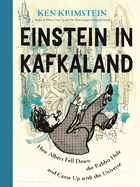
Consider the times and places that have changed the world, and it's unlikely that Prague in 1911 comes to mind. Still, Ken Krimstein (The Three Escapes of Hannah Arendt) makes an effective argument for its critical importance with Einstein in Kafkaland: How Albert Fell Down the Rabbit Hole and Came Up with the Universe, a graphic narrative that blends theoretical physics and experimental fiction, along with references to Lewis Carroll's beloved Alice's Adventures in Wonderland.
Einstein in Kafkaland is an appealing contribution to conversations about these two undeniably significant figures, with its unexpected wit and its clever narrator--a skeleton adorning Prague's famed astronomical clock. Krimstein rightsizes these giants in their respective fields, reminding readers of their humanity. Despite the unquestioned genius of his findings, Einstein in 1911 is "a financially strapped 32-year-old father of three who's had to drag his family" to Prague, where he's struggling to cement his scientific standing and wrestling with the problem of gravity. Kafka, for his part, is "still living at home with his parents, and unless you count a couple press releases, virtually unpublished."
Einstein in Kafkaland's overall design is highly satisfying, due to its detailed illustrations and use of visual humor. Krimstein's art style works particularly well here, as the limited color palette and sketch-like line work evoke a dream state reminiscent of Alice in Wonderland. Deep familiarity with theory is not required, though it may increase readers' appreciation. Krimstein's back matter, which includes notes, suggestions for further reading, and a timeline, will sate most readers' curiosities and send them down their own rabbit holes of discovery. --Sara Beth West, freelance reviewer and librarian

